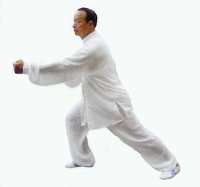Chen Bing is one of dozens of martial arts instructors visiting Seattle this year.
Chen Style Taiji: 38-posture form
Unlocking human potential through martial arts
Chen Bing is one of dozens of martial arts instructors visiting Seattle this year.
Chen Style Taiji: 38-posture form
In theory, the Seattle Martial Arts Club has no teacher. Members meet to practice martial arts drills and exercises of their choosing, under their own direction, for the benefit of all involved.
In practice, no two practice partners are ever equal, and the partner in control usually sets the pace and the tone of a practice session—if not intentionally, then haphazardly.
As I am often the senior Taiji practitioner in attendance—or in other words, the unpaid and under-appreciated Taiji instructor in attendance—it seems appropriate to briefly discuss my personal guidelines and preferences for tui shou (pushing hands) practice.
Many long-term students of Taiji enjoy improvements in their metabolic and kinesthetic efficiency. They burn fewer calories, and expend less effort, to accomplish the same amount of work, whether that “work” consists of repeating the Taiji forms or any other activity.
When food is scarce and plain, this efficiency is an obvious benefit. For most people living in developed countries today, however, food is abundant and tasty. To a person who has become addicted to eating—as the majority of Americans are, studies show—this hard-earned fruition of Taiji is actually a problem: it makes you fat. (Technically, eating the food makes you fat, but let us ignore that detail, as everyone does.)
Dedicating oneself to longer and more strenuous practice might seem like an intelligent solution. Unfortunately, this is likely to accelerate the efficiency gains, exacerbating the problem in the long run. If we choose to define physical fitness as effort and exertion, then Taiji is a lousy fitness routine.
A comfortable and plausible short-term solution: redefine success as failure, and vice-versa. Prioritize effort expended, rather than work accomplished. Sure, your new Taiji may be less functional, but at least you’ll look good doing it!
The more responsible, but less appealing solution is to start eating within your means: to consume calories in accordance with physical needs, rather than insatiable desires. In the meantime, returning to one’s target weight requires a disciplined starvation diet, in conjunction with regular exercise.
Can we view this scenario as a metaphor for the United States economy?

Platypus: The Unofficial Mascot of MMA
Sporting a duck’s bill, otter’s feet and beaver tail, the platypus is considered by some to be the greatest combination of all animals.
Photo credit: striatic
While many Chinese martial arts take inspiration from animals—Tibetan Crane Kung Fu, Monkey’s Fist, Dragon Style, and White Ape Boxing are just a few popular examples—Tai Chi Chuan uses dreary references to binary arithmetic. Small wonder, then, that most people consider Tai Chi boring. It has a serious image problem.
To remain competitive with the thrilling spectacle of mixed martial arts, Tai Chi Chuan should adopt a provocative animal mascot. But what kind of animal best embodies Tai Chi’s unique qualities?
On August 8, 2008, Beijing staged most the elaborate opening ceremony in Olympic history. 2008 Tai Chi performers played their form in perfect synchronicity. Enjoy these pictures and video clips from their spectacular demonstration.

Martial arts are systems of codified practices and traditions of training for combat. While they maybe studied for various reasons, martial arts share a single objective: to defeat a person physically or to defend oneself from physical threat.
~ Wikipedia
Wikipedia’s simplistic definition begs the question: martial arts are martial arts. The statement itself is neither true nor untrue—it is a game rule—but it does reflect an ignorance of, or perhaps a malevolence towards historical facts. Taken at face value, it encourages a dismissive, one-dimensional analysis of the arts’ tremendous potential.
To avoid limiting our achievement in the martial arts, we should begin with an honest and dispassionate accounting of the past. What was the real original purpose of various “martial arts”?
The first clues may be found in our forefathers’ own speech and writings.
“Tell me, Subhuti,” Buddha inquired, “Can an arhat think to himself: ‘I have attained the realization of an arhat’?”
Subhuti, his disciple, replied, “Of course not. With such a thought, he would be grasping to the illusory notions of an ego, a personality, and an individual self. Any so-called arhat who holds these notions is a fake.”
~Diamond Sutra
The meaning of “investing in loss”, as originally recommended by the late Tai Chi master Cheng Man-Ching, was to neutralize a superior force through the practice of non-contention:
Now when I say, “Learn to invest in loss,” who is willing to do this? To invest in loss is to permit others to use force to attack while you don’t use even the slightest force to defend yourself. On the contrary, you lead an opponent’s force away so that it is useless.
Against genuinely applied force, the method is so difficult to apply that it usually fails; thus, it is called a loss. After becoming familiar with every misapplication of wuwei, the non-contention principle, one can eventually start using it correctly and effectively; thus, it is called an investment.
Investing in loss can be a tiresome and disheartening method, but it is a reliable one. Sadly, the term is often misapplied as a catch-all justification for fruitless endeavors. Not every loss qualifies as an investment.

The positive effects of Tai Chi Chuan training on balance and stability are well known. Clinical studies have shown that, with as little as a few weeks of Tai Chi practice, students are significantly less likely to fall down accidentally, inside or outside of class. From a martial arts perspective, they are also less vulnerable to trips, throws and takedowns.
Not every slow-motion exercise routine is worthy of the name Tai Chi, though. The subtle details of your performance will determine whether your practice is excellent balance training, or just marginally beneficial. Here are three adjustments to enhance your Tai Chi form practice for improved balance:
Tell the truth, pretty boy. You don’t really care whether your martial art works on the streets. You just want to burn calories and build muscle, because that is what works on the beach.
So let me warn you: although Taijiquan can benefit your health, your physical appearance will pay the price.
This is a distillation of previous published interviews with Master Wang.
Having traveled across China, I know that Taijiquan has the most practitioners of any martial art. Upon hearing that this boxing method was handed down from Zhang Sanfeng, I despised him for a long time.
Taijiquan is far from the art of actual combat; they have nothing in common with each other.
Later on, I read the collected edition of Zhang Sanfeng’s teachings, and realized that he had progressed deeply into the great Tao—and I came to believe that Taiji was not handed down from him at all! Actually, it doesn’t matter; even if one is a descendant of Sanfeng, he is not worthy to talk about this method without first gaining its essence.